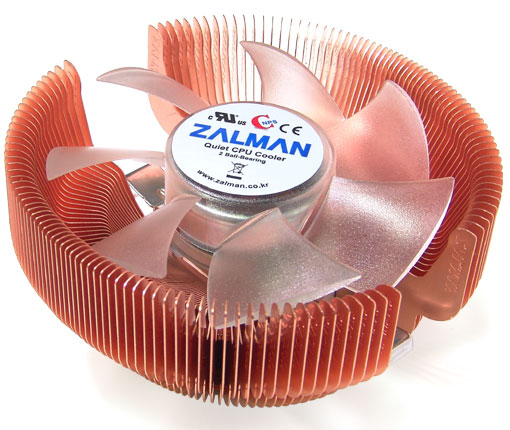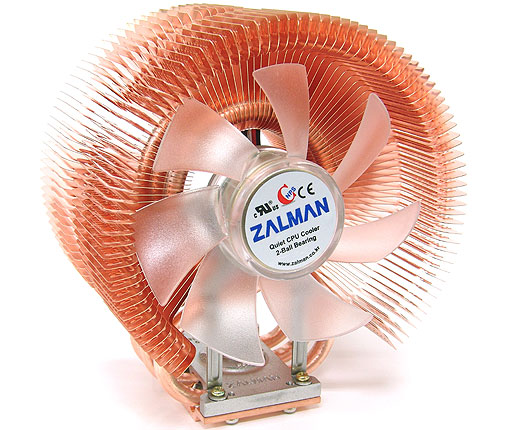The Zalman Twins: 9500 & 9700 Air Tunnels
by Wesley Fink on February 19, 2007 12:40 AM EST- Posted in
- Cases/Cooling/PSUs
Zalman is a name that instantly comes to mind with Computer Enthusiasts when cooling is mentioned. However, Zalman built its reputation with low-noise products and not with high performance. Silence and Zalman go hand-in-hand, but that is not normally the same as best performance. Zalman is a company that builds an exotic fanless power supply, a fanless GPU cooler, the Reserator 2 fanless water-cooled case, and huge copper fin CPU coolers with large, low-speed fans for cooling.
To be frank, Zalman most likely is the reason for the current fashion of large fans running at slow speeds, which has proven to provide superior cooling with much lower noise than smaller fans running at high speeds. A South Korea based company, Zalman has quickly grown in the past few years from a "good-idea" product to a huge product line based on the silent or low-noise cooling concept. With the growth have come additional offices, with US offices located in Garden Grove, California.

The CNPS9500 and CNPS9700 families are roughly based on the current thinking about heatpipe tower cooling - with a Zalman twist. From the very first Zalman coolers a few years ago, we have seen huge multi-finned circular coolers with a large, proprietary contained cooling fan. The CNPS7500 you see above is a good example of the typical Zalman CPU cooler.

Last year Zalman introduced an update to this concept in the Zalman CNPS9500. The 9500 turned the large orb on its side, supported by looped heatpipes that claimed the efficiency of a six heatpipe design. Zalman had their version of the increasingly popular and effective heatpipe tower.

A few weeks ago at CES, Zalman introduced a larger version of the 9500 which they call the CNPS9700. The larger all-copper 9700 increased the embedded fan size from 92mm to 110mm. This provided a larger and higher capacity "air tunnel" for cooling.
With so much attention from Zalman on cooling, the obvious question is whether the Zalman 9500 and 9700 continue the Zalman tradition of ultra quiet cooling. Does Zalman still lead the pack in quiet designs, or have competitors caught up? There is also the important question of whether the Zalman is also a good choice for performance cooling. Large fans move a lot of air at low noise, so are the Zalman 9500 and 9700 CPU coolers a good choice for the overclocker?
To be frank, Zalman most likely is the reason for the current fashion of large fans running at slow speeds, which has proven to provide superior cooling with much lower noise than smaller fans running at high speeds. A South Korea based company, Zalman has quickly grown in the past few years from a "good-idea" product to a huge product line based on the silent or low-noise cooling concept. With the growth have come additional offices, with US offices located in Garden Grove, California.

The CNPS9500 and CNPS9700 families are roughly based on the current thinking about heatpipe tower cooling - with a Zalman twist. From the very first Zalman coolers a few years ago, we have seen huge multi-finned circular coolers with a large, proprietary contained cooling fan. The CNPS7500 you see above is a good example of the typical Zalman CPU cooler.

Last year Zalman introduced an update to this concept in the Zalman CNPS9500. The 9500 turned the large orb on its side, supported by looped heatpipes that claimed the efficiency of a six heatpipe design. Zalman had their version of the increasingly popular and effective heatpipe tower.

A few weeks ago at CES, Zalman introduced a larger version of the 9500 which they call the CNPS9700. The larger all-copper 9700 increased the embedded fan size from 92mm to 110mm. This provided a larger and higher capacity "air tunnel" for cooling.
With so much attention from Zalman on cooling, the obvious question is whether the Zalman 9500 and 9700 continue the Zalman tradition of ultra quiet cooling. Does Zalman still lead the pack in quiet designs, or have competitors caught up? There is also the important question of whether the Zalman is also a good choice for performance cooling. Large fans move a lot of air at low noise, so are the Zalman 9500 and 9700 CPU coolers a good choice for the overclocker?










50 Comments
View All Comments
Scorpion - Wednesday, February 21, 2007 - link
Page 5 states:So for 30 minutes, you capture 450 data points. It's expected that the data will ramp up over the 30 minute interval and reach an approximately linear stability region towards the end.
I have a problem with your measurement evaluation and findings. I do not think this is a very conclusive or accurate measurement and evaluation criteria. This information could be useful, yes, but only as an additional evaluation criteria.
All tests need a good, quantifiable evaluation metric. The "goodness" of a test is only as good as that metric. And I conclude that what you've chosen is a poor metric. Your posterior evaluation is highly influenced by noise. The maximum could be the result of a large noise addition to the measurement.
A better choice would have been to analyze the data results from all the tests to determine a stability region in the latter part of the data measurements, for all tests. Treat the data in that region as a random variable and take the expectation over that region. That would give you a much better evaluation criteria. You could also compute the variance of the data in this region to determine how stable the performance is for each cooler. This could also be a useful metric, although I know that this may not mean much to your typical audience. Another interesting metric would be to evaluate the other region in the data, in order to measure how quickly temperature ramps up. Or put into other words, how quickly each fan responds to temperature changes.
I'm saddened to see a good and useful article brought down by it's poor evaluation criteria. It effectively reduces the confidence in your conclusions.
Wesley Fink - Friday, February 23, 2007 - link
We try to answer two questions in our cooling tests. First, most users beef up cooling to improve overclocking. We determine the highests stable overclock using a standard CPU/test bed by finding the overclock the cooler can maintain for 30 minutes of looping a demanding game. The highest OC is a very good measure of the effectivenes of the cooler and is compared to other coolers. We also measue and report the highest temperature in this load condition - and yes it does spike up and level off as you suggest. We haven't seen the huge spikes you might fear are there in our test data. Temps rise quickly and stabilize at the temp we report. This is a good indication of cooler efficiency.Second, some users beef up cooling to reduce noise. We also report the lowest noise measurements for the cooler we are testing.
Your suggestions would provide much useful information, and we may add additional testing in the future. However, for now, we are trying to cut through all the hype surrounding cooler testing and provide as much useful info to our readers as possible in a timely manner. We are comfortable that we answer the two questions above in our cooler reviews, and those are the main questions our readers are always asking us about cooler performance.
cyberkost - Tuesday, February 20, 2007 - link
I did not quite get the methodology of the noise level comparisons...Were the coolers required to provide "same cooling performance" (e.g., same CPU temperature some long time into running some stress test)? It does not seem that they were. I'm worried about Anandtech intending to adapt the noise-comparison technique described in this article. The proper technique (IMHO) would be:
1) install cooler
2) run a stress test
3) dial cooler RPM till a (judiciously) chosen (same for all coolers) CPU temperature is achieved (say 40C) in a stable manner
4) record the noice level and put it on the comparison chart
strikeback03 - Tuesday, February 20, 2007 - link
Reading the respective reviews, it would appear that at stock speeds (and possibly some others) that the Katana, for example, does not get as cool as the Tuniq even when the Katana is at max RPM and the Tuniq at minimum.rjm55 - Tuesday, February 20, 2007 - link
Can you please review the Austrian Noctua NH-U12. I've seen good and bad reviews and I want to see what you find.gloutch - Tuesday, February 20, 2007 - link
The performance of those headpipes coolers is reduced if not properly oriented.SO: What was the position of the Zalmann coolers during the test ????????????????????
Wesley Fink - Tuesday, February 20, 2007 - link
From page 4 - CPU Cooling Test Configuration:"All cooling tests are run with the components mounted in a standard mid-tower case. The idle and stress temperature tests are run with the case closed and standing as it would in most home setups. We do not use auxiliary fans in the test cooling case, except for the north bridge fan attached to the 680i for overclocking."
As an aside we have found the impact of heatpipe cooler orientation to be pretty small - we just don't leave that test criteria to chance. An article on the impact of heatpipe cooler orientation on performance could be interesting.
orion23 - Monday, February 19, 2007 - link
Hi!Thanks for this awesome review. Only 2 top coolers left to review:
Thermalright Ultra 120
Scythe Infinity!
It is great to see Anandtech starting to review other PC components such as CPU Coolers and RAM. Things can be very quiet around here unless a new CPU, GPU or MotherBoard comes along......
Hopefully this is only the beginning of a new Anandtech that will review other important PC components such as the PSU, CPU Coolers, (AIR / Water), Fan Controllers...
It wouldn't hurt to have more stuff to read around here!
DrMrLordX - Tuesday, February 20, 2007 - link
Actually, the SI-128 and Noctua NH-U12F probably deserve a review at some point as well. Maybe even the Scythe Mine? The Mine can supposedly outperform the Ninja when using high-cfm fans, but your guess is as good as mine when it comes to actually mounting a 120mm fan on the Mine that normally takes a 100mm fan.DrMrLordX - Tuesday, February 20, 2007 - link
Woops, I forgot the Big Typhoon and Big Typhoon VX.